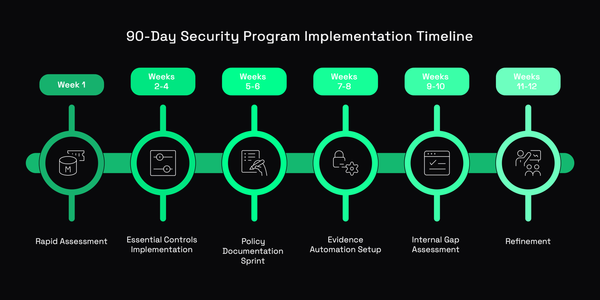Turning Executives into APT-Slayers Through ERM

Nikoloz Kokhreidze
Equip your executives to combat Advanced Persistent Threats (APTs) with targeted Enterprise Risk Management (ERM) training to grow business with confidence.

As cyber threats become more sophisticated and damaging, executives need to understand the risk posed by advanced persistent threats (APTs). The best way to do this is through comprehensive enterprise risk management (ERM) training. ERM training programs can equip executives with the knowledge they need to mitigate the risk posed by APTs and protect their organizations from malicious actors.
What Are Advanced Persistent Threats?
Advanced Persistent Threats (APTs) are a type of cyber attack in which an attacker establishes a long-term presence on a network to steal sensitive information. APTs are typically carried out by state-sponsored groups or well-funded criminal organizations and are characterized by their advanced tactics, techniques, and procedures (TTPs). These attacks often involve custom malware and zero-day exploits and can evade detection by traditional security systems. APTs typically aim to steal sensitive information, such as intellectual property, trade secrets, and personal data, rather than causing destruction or disruption. These attacks are often difficult to detect as they are designed to be stealthy and evade traditional security measures.
What Is Enterprise Risk Management Training?
Enterprise Risk Management (ERM) training is a program or course that educates executives and employees on the principles and practices of identifying, assessing, and mitigating risks within an organization. ERM training aims to ensure that employees at all levels of the organization are aware of the company's potential risks and are equipped with the knowledge and skills needed to manage those risks effectively. Training programs can be designed to teach executives about the dangers posed by APTs and how to manage them effectively. ERM training programs are comprehensive, covering topics such as cyber security, data protection, risk management strategies, and crisis management. These programs also teach executives how to identify, assess, and mitigate risks before they become a problem.
Is Security Blocking Your Next Enterprise Deal?
Let's discuss how fractional CISO services can unlock your pipeline without the full-time overhead.
The Benefits of ERM Training for Executives
There are several key benefits to ERM training programs for executives. These include:
- Increased Awareness of APT Risks: ERM training for executives can help them understand the specific types of APT risks that their organization may face and the potential impact of these risks on the company. This increased awareness can lead to better-informed decisions about how to protect the organization from APT attacks.
- Improved Risk Assessment Skills: Executives who receive ERM training will learn how to identify and assess APT risks and vulnerabilities in their organization. This can help them prioritize the risks that need to be addressed and develop effective strategies for mitigating them.
- Improved Risk Management Strategies: ERM training programs teach executives how to identify and assess risks before they become a problem. This helps executives develop effective risk management strategies to mitigate the risk posed by APTs and other cyber threats.
- Improved Crisis Management: ERM training programs also teach executives how to respond quickly and effectively to a cyber attack or other crisis situation. This helps ensure that organizations are prepared for any situation and minimizes the potential for damage or disruption caused by malicious actors.
- Enhanced Incident Response Capabilities: ERM training for executives can help them understand the importance of incident response planning and preparation during an APT attack. This can enable them to respond more effectively to an attack, minimizing the damage and restoring normal operations more quickly.
- Better Alignment of Risk Management with Overall Strategy: Executives who receive ERM training will learn how to align their organization's risk management efforts with its overall strategic objectives. This can ensure that the company's resources are being used effectively to protect against APT risks while also supporting its growth and success.
- Better Communication and Collaboration Across the Organisation: ERM training for executives can help them understand the importance of effective communication and cooperation in managing APT risks. This can lead to better coordination between different departments and functions within the organization, which can be crucial in preventing and responding to APT attacks.
Organizing Enterprise Risk Management Training for Executives
Organizing and executing Enterprise Risk Management (ERM) training for executives to handle Advanced Persistent Threat (APT) risks can be a multi-step process, which can include the following steps:
- Identify the Training Needs: The first step is to identify the specific training needs of the executive team about APT risks. This can involve assessing the organization's current knowledge and understanding of APT risks and identifying gaps in the executive team's skills or abilities.
- Develop the Training Program: Once the training needs have been identified, the next step is to develop a training program that addresses those needs. This can involve working with a training provider or subject matter expert to create a program tailored to the organization's specific needs and goals.
- Schedule the Training: After the training program has been developed, the next step is to schedule the training sessions. This can involve identifying a suitable date, time and location for the training, as well as arranging any logistics, such as accommodations or travel for attendees.
- Deliver the Training: The next step is to deliver the training to the executive team. This can involve in-person workshops, online courses, webinars, or simulations. It is important that the training is interactive, engaging, and tailored to the audience.
- Evaluate the Training: After the training has been delivered, it is crucial to evaluate its effectiveness. This can involve collecting feedback from the attendees, assessing the impact of the training on their knowledge and understanding of APT risks, and measuring any improvements in the organization's risk management capabilities.
- Continuous Improvement: Based on the evaluation, make adjustments and improve the training program and delivery to ensure the effectiveness of the training over time.
Conclusion
The threat posed by advanced persistent threats (APTs) is a growing concern for organizations across the globe. Executives need to understand the risk posed by APTs and comprehensively understand how to mitigate them. Comprehensive enterprise risk management (ERM) training programs can equip executives with the knowledge they need to protect their organizations from malicious actors. ERM training programs provide executives with an in-depth understanding of the risks posed by APTs and teach them how to identify, assess, and mitigate these risks before they become a problem. They also help ensure that organizations are prepared for any situation and minimize the potential damage or disruption caused by malicious actors.



